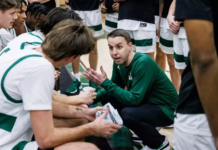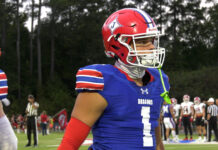
The Georgia High School Association approved and announced changes to the 2023-24 GHSA Constitution, which allows high school athletes in Georgia to benefit from their name, image and likeness.
With the new bylaw (1.97), Georgia becomes the 30th state, along with the District of Columbia, to allow its member schools’ athletes to profit from their name, image and likeness (NIL).
The Georgia High School Association (GHSA) has, of course, added in limits or restrictions as to how the athletes can conduct themselves in accordance with the new bylaw while maintaining their amateur status as an athlete.
The different restrictions are spelled out in “Appendix ‘N’”, which can be found on page 131 of the 191-page GHSA Constitution.
Athletes can benefit from NIL assuming they comply with bylaw 1.92-c, which means “the compensation is not contingent on the specific athletic performance or achievement,” or “the compensation is not provided as an incentive to enroll or remain enrolled at a specific school,” or “the compensation is not provided by the school or any person acting as an agent for the school.”
There also cannot be a violation of bylaw 1.70, which defines the rules against recruiting, undue influence, following the coach, and booster involvement.
Where the NIL bylaw starts to get tough for student-athletes is in the guidelines specific to the bylaw, which are as follows:
- Intellectual property – No “marks” may be used including, but not limited to, school logos, school name, school uniforms, school mascot, or any trademarked GHSA logo or acronyms.
- No school apparel or equipment shall be worn, which includes school name, school uniforms, school logo, school mascot or any apparel displaying trademarked GHSA logos or acronyms.
- No member school facility may be used for the purpose of name, image and likeness activities.
- No activities in conflict with a member school’s local school district policy may be endorsed. (Examples include, but are not limited to, tobacco products, alcohol products and controlled substances.)
- Students and their families should seek professional guidance as to how NIL activities could impact collegiate financial aid and/or tax implications, among other issues.
- Within seven (7) calendar days after entering into any type of NIL contract/agreement, a student, or the student’s parents/guardians, must notify the Principal or Athletic Director of the student’s school of entering into that agreement.
Essentially, to be in compliance, athletes cannot wear anything associating them with their school or the GHSA. The ads athletes may be included in cannot have logos or anything associating them with their school or the GHSA. They cannot be on grounds of school facilities, advertise something against school district policies, and they have to alert school officials of their deal within seven days of signing on the dotted line.
Habersham Central High School Head Football Coach Benji Harrison sees some potential issues with what the GHSA has outlined thus far in terms of rules to follow.
“They’re very, very vague. Very vague,” Harrison said. “My worry is whenever you roll out something like this, just like you see in college, I don’t think the intentions are bad, but the execution of it can be dangerous.”
HCHS Athletic Director Geep Cunningham isn’t in favor of the bylaw.
“Change isn’t always good. I don’t think this is good,” Cunningham said.
“Giving high school kids financial backing to play sports, to me, is ridiculous. I don’t know how else you say it,” he continued. “Then again, I feel the same way about it in college. I just don’t get it at all myself. That doesn’t make me right, that’s just how I feel.”
Harrison said he’s talked with several high school coaches about NIL and nobody has really had time to look into it yet and, without further guidance from GHSA, there are still tons of questions about it.
“I’m not necessarily for or against it,” Harrison said. “But What does it look like at the high school level? What does it look like from different location to location? How does it look across the board with all sports?”
In Cunningham’s eyes, this is just a policy put in place to keep the GHSA from getting sued like when college student-athletes went after the NCAA and EA Sports for using their name, image and likeness in video games without compensation. That case, referred to as Keller litigation by the NCAA, was settled in 2014.
Harrison said he sees adding the bylaw to possibly be the GHSA’s way of trying to keep top talents in-state rather than them going to other states where NIL was available to them.
As it’s written, within the guidelines, the athletes set to benefit from NIL are those recruits of the highest regard.
For example, Buford High School quarterback Dylan Raiola, who is committed to the University of Georgia and moved to Buford from California a year ago to lead the Wolves’ offense this season, has an NIL valuation of $770,000 according to the website on3.com. Among all athletes eligible for NIL deals, including college athletes, that valuation places Raiola at No. 51 on On3’s top 100. For high school football, he lists at No. 2 behind Carlsbad, Calif., quarterback and Alabama commit Julian Sayin, whose number sits at $803k. Raiola is the No. 1 pocket passer and No. 8 overall player in the nation for the class of 2024 on ESPN’s Top 300.
Safety KJ Bolden, a Florida State University commit that also plays at Buford High, is ranked No. 10 on the On3 high school football NIL list with a valuation of $432k. ESPN has Bolden ranked as the No. 1 safety and 15th overall player in the nation for the class of 2024.
Outside of those that are highly touted by top recruiting sites and getting publicized official visits to Division I schools, there’s also the side of high school athletics that are seemingly pushed to the side by GHSA officials, but widely talked about amongst fans and parents: recruiting.
“I think the people that will benefit are the people that operate completely differently than we operate at Habersham,” Cunningham said. “I think that the people that move them around, bring them in, send them out, do all those kinds of things – this is what they’ll use as enticement to get “Billy Bob” to come from School A to their school.
“If you’re not going out and trying to do things to get new kids to move into your school just to play sports – if you’re not doing that – then [NIL is] not going to affect you or your school. Unless you lose out to somebody else coming to get your guys or girls,” he continued.
Coaches, or parents and players on the behalf of coaches, are already contacting students at other schools with the intention of luring them to play for the coaches’ school. It happens all over the place, especially in higher populated areas with multiple schools in the same district.
It’s one of the worst kept secrets at the high school level.
“Obviously they say this won’t be used for recruiting. Yeah, OK. We already have issues with that,” Harrison said. “This, to me, can’t make it any better. I think that’s the biggest concern.”
“If people think, right now, that schools are not approaching kids to come to their school, if people believe that’s not happening, which is totally against the rules and totally illegal, but if people think that’s not happening, they’re just blind to what’s going on,” Cunningham said.
Cunningham said he’s had multiple conversations over the years with student-athletes that are going to visit other high schools.
“Everybody is looking to get their deal. Everybody is looking to get their scholarship and all those kinds of things,” Cunningham said. “We’ve lost the love of just playing the game and being with your teammates and friends at school. We’ve lost that idea and thought. That being said, we, at Habersham Central, may be closer to still holding on to that thought than others.”
The times of kids playing youth sports and anticipating the day they get to don their high school’s colors and jersey seem to be fading with all of the transfers that happen now.
“I think about high school sports and the intention was to be part of the high school experience,” Harrison said. “I think high school athletics goes side-by-side with what happens in the school building every day to develop kids – their character, their toughness, their discipline, their responsibility. Then pair that with the support of the community and how fun that is. That, to me, is what high school sports is about.
“When you bring something in like [NIL], it runs the risk of ruining something that has been really, really, really good and right for a long time,” Harrison continued.
The fading of the desire among kids to one day wear their high school colors is not something that Cunningham sees affecting Habersham Central much.
“The comments that you would hear sometimes at Habersham from a kid or a momma about her kid would be, ‘all he’s ever dreamed about is playing for the Raiders,’” Cunningham said. “I believe that. I wholeheartedly believe that. I don’t believe you hear that at every school, but I do believe that in Habersham County.
“I think that’s what makes the school and school system that we’ve got so special,” he continued. “I think that’s what makes our place more special than any others I know of. I hope we can hold onto that as long as we can. But I’m afraid we’re going to fight for it if we’re going to keep it.”
“I haven’t given [NIL] a lot of thought. I will when the time comes and we’ll figure it out, but I think there’s got to be a little more to it than what we know right now before you can jump to any conclusion,” Harrison said. “It’s really in the infancy stage of it right now. I think you’ve got to kind of see what it’s all about first and then make good decisions.”
The bylaw went into effect back on October 2, when it was approved, but it will likely take a few years before the effects on high school sports in Georgia are fully realized.




![Vikings hold on to win top-10 thriller against Jefferson [VIDEO]](https://nowhabersham.com/wp-content/uploads/2025/01/maxresdefault-7-218x150.jpg)
![Aldridge paces Lady Dragons to 11th straight win [VIDEO]](https://nowhabersham.com/wp-content/uploads/2025/01/maxresdefault-6-218x150.jpg)
